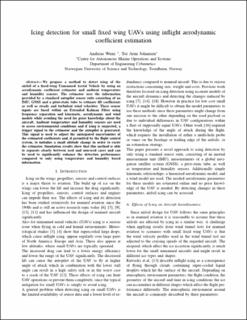| dc.contributor.author | Wenz, Andreas Wolfgang | |
| dc.contributor.author | Johansen, Tor Arne | |
| dc.date.accessioned | 2020-03-23T11:28:50Z | |
| dc.date.available | 2020-03-23T11:28:50Z | |
| dc.date.created | 2019-09-06T13:50:18Z | |
| dc.date.issued | 2019 | |
| dc.identifier.issn | 1095-323X | |
| dc.identifier.uri | https://hdl.handle.net/11250/2648085 | |
| dc.description.abstract | In cold and humid environments, airfoil icing is a major hindrance to UAV operations. Airfoil icing increases the aerodynamic drag coefficient, while reducing the maximum lift coefficient and the stall angle. This results in degraded endurance and safety of an UAV. Recently de-icing solutions for fixed-wing UAVs have been developed. These solutions use resistive heating in order to melt the ice on the wings. However, since this requires a high amount of energy it is desirable to only heat the wings if significant icing occurs. In this paper, a method for automatic icing detection is presented. A moving horizon estimator (MHE) is used, which combines aerodynamic, kinematic and stochastic wind models with data from a typical autopilot sensor suite to estimate angle of attack and lift coefficients. The sensor suite consists of an inertial measurement unit (IMU), a global navigation satellite system (GNSS) receiver, a heading reference and a pitot-static tube. Within the MHE an Unscented Kalman Filter (UKF) is used for arrival cost approximation. FENSAP icing simulations show that in severe icing conditions, both the offset and the gradient of the lift coefficient change. Based on these icing simulations an UAV flight simulator that can simulate icing has been used. Simulation results show that the MHE is capable of monitoring changes in offset and gradient of the lift coefficient due to icing. A faster convergence to the estimated coefficient values could be achieved when using an external trigger signal, i.e. from a temperature and humidity sensor, to reset the covariance matrix of the arrival cost. We also investigate the effect on convergence speed resulting from an altitude change giving additional excitation. The estimation results show angle of attack estimation errors below 1 degree. These estimates can be used to limit the angle of attack and adjust the commanded airspeed in the autopilot in order to avoid stall. | en_US |
| dc.language.iso | eng | en_US |
| dc.publisher | Institute of Electrical and Electronics Engineers (IEEE) | en_US |
| dc.title | Icing Detection for Small Fixed Wing UAVs using Inflight Aerodynamic Coefficient Estimation | en_US |
| dc.type | Peer reviewed | en_US |
| dc.type | Journal article | en_US |
| dc.description.version | acceptedVersion | en_US |
| dc.source.volume | 2019-March | en_US |
| dc.source.journal | IEEE Aerospace Conference. Proceedings | en_US |
| dc.identifier.doi | 10.1109/AERO.2019.8742134 | |
| dc.identifier.cristin | 1722326 | |
| dc.relation.project | EC/H2020/642153 | en_US |
| dc.relation.project | Norges forskningsråd: 233254 | en_US |
| dc.description.localcode | © 2019 IEEE. Personal use of this material is permitted. Permission from IEEE must be obtained for all other uses, in any current or future media, including reprinting/republishing this material for advertising or promotional purposes, creating new collective works, for resale or redistribution to servers or lists, or reuse of any copyrighted component of this work in other works. | en_US |
| cristin.unitcode | 194,63,25,0 | |
| cristin.unitname | Institutt for teknisk kybernetikk | |
| cristin.ispublished | true | |
| cristin.fulltext | postprint | |
| cristin.qualitycode | 1 | |
